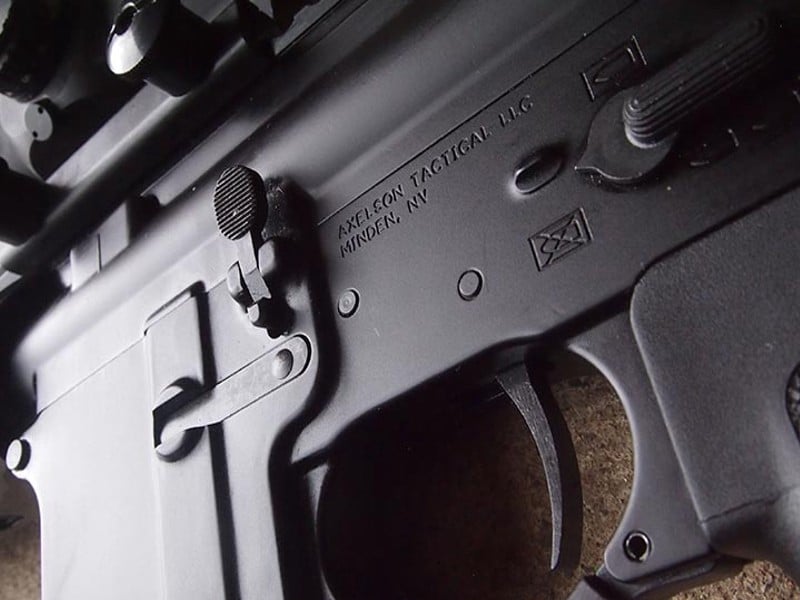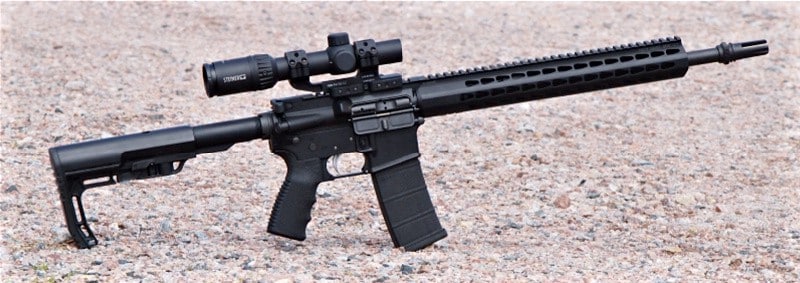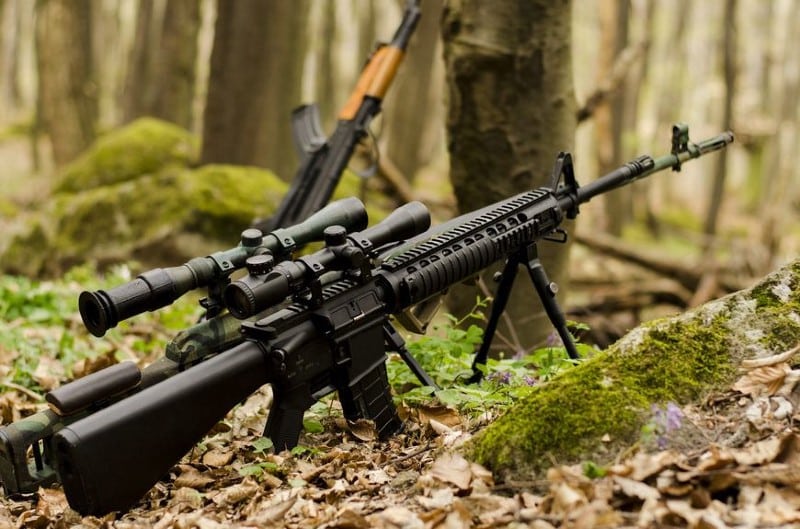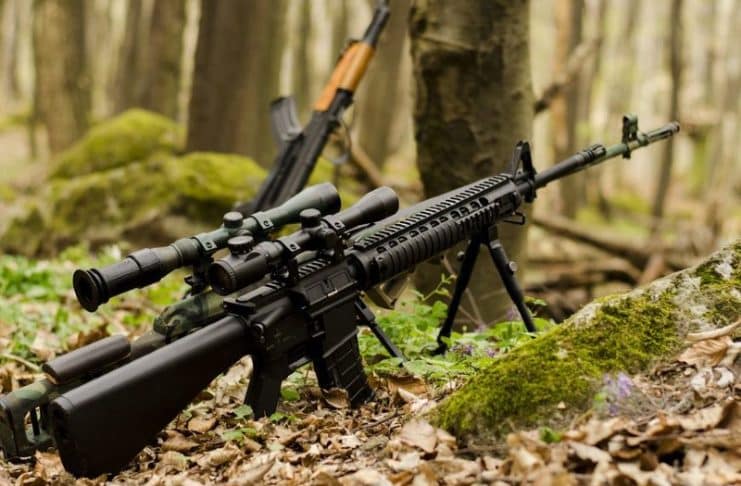AR-15s have a lot of parts — an average of 100 per rifle — and many uses. Thanks to the many components and uses of the AR-15 rifle, there are also a ton of words you should know. Why does AR-15 terminology matter? Because it's hard to talk about an AR-15 when you don't know the specific words for things. Plus, being an educated gun owner is never a bad idea.
GunMag Gun School: AR-15 Terminology

Disclaimer: This isn't a totally exhaustive list of AR-15 parts and terms, just a way to get you started.

AR: We're including this to dispel the myth that “AR” stands for “assault rifle.” The “AR” in AR-15 stands for “ArmaLite Rifle” and refers to its original designation. Interestingly, the first ArmaLite Rifle was an AR-10, not an AR-15.
AR-10: Yes, the AR-10 needs to be included on an AR-15 list, because it helps clear up any confusion. The AR-10 platform is larger than the AR-15 and is designed for cartridges like 308 Winchester, 6.5 Creedmoor, and 300 Winchester Magnum. It's a more proprietary platform than the AR-15 rifle, too; to build an AR-10 you're restricted to matching specific receivers, among other things.
AR-15: The AR-15 rifle — or pistol — is a lightweight, semi-automatic platform that was designed by none other than Eugene Stoner in the 1950s. There's an entire somewhat confusing history behind the invention of the AR-15 , but we won't get into that here. These guns are best known for being chambered in 223 Remington or 5.56 NATO, but they're available in a lot of other chamberings, too.
AR Pistol: An AR platform that usually has a very short barrel length, such as 10 inches or less, and a padded buffer tube or pistol brace instead of a stock. AR pistols cannot legally have stocks and are meant to be designed to fire braced against the shooter's forearm.
Barrel: While it might seem obvious, it's worth mentioning. Barrels are the metal tubes located inside the handguard of an AR-15 that the bullet travels down when the gun is fired. AR-15 barrels are made from a variety of metals and quite a few different chamberings and lengths.
Barrel Nut: This is a term worth knowing because it's a major part of your AR-15. If your AR-15 rifle has a free-floating handguard, there's going to be a barrel nut — a circular part with a threaded inside — holding the breech end of the barrel onto the upper receiver.
BCG (Bolt Carrier Group): Without this assembly, your AR-15 won't fire. The BCG contains the firing pin, bolt, and bolt carrier (plus a handful of smaller parts such as gas rings). Some AR-15 owners believe the BCG is the heart of the AR-15 and perhaps its most important part.
Bipod: A two-legged accessory that mounts to the muzzle end of the handguard for the purpose of holding the front of the gun up off whatever surface it's resting on. It also helps hold the gun steady by keeping it more stable during live fire. Proper bipod use is important to reap the full benefits of having a bipod on your AR-15.

Box Magazine: Visually, these are more like rectangular magazines, but the correct term for the standard AR-15 magazine is “box magazine.” They have varying capacities from 5 rounds to 30 rounds — and more — and a handful of states have restrictions in place regarding the capacity your AR-15 box magazine can have.
Breech: The back of the barrel or rearward portion of the firearm. This is where the term “breech-loading firearms” came from; most modern firearms are breech-loaders as opposed to the muzzleloaders of the early days of firearms invention.
Buffer: This is often used to refer to a single part, or the entire assembly, which includes the buffer tube, buffer spring, and buffer weight. Technically, the sum of those parts is the “buffer assembly” with each individual part being called by its name. The buffer assembly functions to aid the cycling of the gun and also helps mitigate felt recoil.
Butt/Buttstock: The rearmost part of the stock of an AR-15. Often used to refer to the stock itself rather than only the rearward portion of the stock.
Carbine: Usually used when referring to an AR-15 with a barrel length between 16 inches and 20 inches. Legally, if you're going to buy or build an AR-15 rifle — not a pistol — with a barrel under 16 inches, you have to apply for a stamp to keep it law-abiding under the NFA (National Firearms Act).
Chamber: The inside portion of an AR-15 upper receiver where a round of ammunition is loaded — chambered — for firing.
Charging handle: Typically a T-shaped handle at the back of the AR-15 upper receiver, but in front of the stock, that's used to load or clear the chamber of the rifle. Some models of AR-15 have reciprocating charging handles located on the side of the receiver instead of the top.

Direct Impingement Gas System (DI): This was the original AR-15 gas system invented by Eugene Stoner. When gases are created by firing a DI AR-15, they exit through a tiny hole in the top of the barrel at its muzzle end, travel back to the receiver of the AR-15 through the attached gas tube, and facilitate the moving and cycling of the BCG.
Drop-in Trigger: A cassette-style, one-piece aftermarket trigger that can be installed easily by dropping it into the lower receiver of an AR-15 and putting trigger pins in to hold it in place (note: all triggers utilize trigger pins).
Drum Magazine: A cylindrical magazine — yes, shaped like a drum — that holds larger amounts of ammunition such as 50 or 100 rounds.
Ejection Port: An opening in the AR-15 upper receiver where spent brass ejects during live fire. Most ejection ports are located on the righthand side of the upper receiver but there are some left-handed models with a left-sided port.
Finish: The process and substance used to coat an AR-15. Common finishes include anodizing and Cerakote, the latter of which is a brand name but often used to refer to painting an AR-15 with custom colors or designs.
Firing Pin: A small part within the bolt and bolt carrier group of an AR-15 that travels forward during firing to strike the primer of a chambered round of ammunition, igniting it and sending a bullet down the barrel of the gun.
Flash Hider: A muzzle device used to reduce how much flash is visible during live fire. It attaches to the muzzle end of a threaded barrel. Some are designed to work in tandem with muzzle brakes. Other names for this part include flash guard and flash suppressor.
Foregrip: Usually, but not always, an aftermarket addition to an AR-15 rifle. This is a typically cylindrical part that extends vertically from the underside of the handguard and is gripped by the shooter's support side hand during live fire.
Free Floating Handguard: An AR-15 handguard that attaches directly to the upper receiver with a barrel nut. This allows the barrel to “free float” within the handguard rather than being attached, improving barrel harmonics and accuracy.
Front Sight: The sight located at the front of the handguard or barrel. On retro builds this might be a classic A2-style front sight that clamps onto the barrel itself; rail-mounted front sights might be beads, posts, or folding styles.
Gas Block: A small part that fits over the front of the barrel for placement over the gas port and serves to regulate the gas flow back to the AR-15's action during firing.
Handguard: The metal or plastic part of an AR-15 located at the front of the gun, surrounding/covering the barrel. Its general purpose is to protect the shooter's hands from the heat generated during live fire.
KeyMod: A method used to attach aftermarket components to the handguard of the AR-15; the KeyMod modular system was created in 2012 and refers to the key-shaped cutouts of certain handguards. When buying aftermarket accessories, check to see whether they're compatible with KeyMod or M-LOK.

Lower Receiver: The bottom, or lower, part of an AR-15 containing parts including the trigger, safety selector, and stock. The lower receiver attaches to the upper receiver with takedown pins.
M-LOK: A mounting system for AR-15 handguards that was created in 2014 by Magpul. Made for superior compatibility with plastic parts rather than metal. This is an elongated, rounded cutout and has become the most commonly used cutout on the AR-15 market.
Muzzle Brake: A muzzle device that attaches to the threaded muzzle of an AR-15 barrel to mitigate felt recoil and muzzle rise. The threading and caliber of the brake must match the barrel it's being mounted on.
Picatinny Rail: A rail system used to attach accessories to the AR-15 rifle. Also known as MIL-STD-1913, this is the most common rail system on the market. On some handguards, the rail is integral to its design but there are also rails that can be mounted using KeyMod or M-LOK after the fact.
Pistol Grip: Not to be confused with the foregrip, a pistol grip on an AR-15 is the part that extends from the lower receiver and is gripped by the strong-side hand during firing. All AR-15s have a pistol grip, but not all AR-15s have a foregrip.
Quad Rail Handguard: An AR-15 handguard with rails on all four sides rather than only along the top.
Rear Sight: The sight at the back of the AR-15 that's mounted to the rear of the upper receiver, either fixed or folding. The rear sight is used to line up the front sight evenly between its notches to make accurate shots on targets.
Rifle: Technically used to refer to an AR-15 with a barrel of 20 inches in length or longer.
Stock: The rearmost part of an AR-15 that's used to mount the rifle to the shooter's shoulder during firing. Stocks can be fixed, adjustable, and/or folding. An AR pistol cannot legally have a stock.
Trigger: The mechanism within the lower receiver of an AR-15 that's pulled/pressed to fire the gun. Standard AR-15 triggers are basic metal blades installed by fitting multiple components together within the lower receiver.
Upper Receiver: The upper part of an AR-15, specifically the portion that holds the BCG at its rear and attaches to the barrel at the front. The upper receiver attaches to the lower receiver with the takedown pins that are installed on the lower receiver.
Weaver Rail: A rail system designed to make mounting accessories to an AR-15 easier. The spacing and shape of Weaver rails are different than that of a Picatinny rail system, so check for compatibility when purchasing parts that mount to rails.
Read the original article in its entirety at medium.com.


